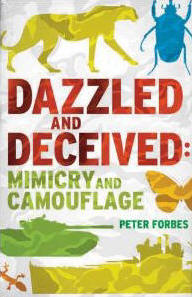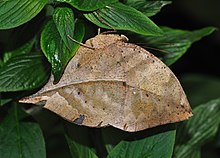Dazzled and Deceived
 | |
| Author | Peter Forbes |
|---|---|
| Subject | Camouflage, mimicry |
| Genre | Popular science |
| Publisher | Yale University Press |
Publication date | 2009 |
| Awards | Warwick Prize for Writing |
Dazzled and Deceived: Mimicry and Camouflage is a 2009 book on
The book was well received by critics, both military historians and biologists, and won the 2011 Warwick Prize for Writing.
Book
Publication
Dazzled and Deceived was published by Yale University Press in 2009 in English and also translated into Korean.[1]
The book contains 34 colour plates and six monochrome maps and drawings.
Contents

The book looks at the history of
Forbes describes how an American artist,
Forbes rounds off the book by looking at the genetic basis of camouflage in butterflies, which has been studied extensively, from the early work (starting in 1954) of
Prizes
The book won the 2011 Warwick Prize for Writing.[5]
Reception
Military history

The

Veronica Horwell, in
The History of War encyclopedia website commented that their review was of possibly the only book on evolution they would ever publish, for its four useful chapters on the history of military camouflage including First World War dazzle camouflage and, flourishing in the Second World War, everything from inflatable dummy tanks to the deception preparations for El Alamein. They comment that the story of scientific research is fascinating, and that "Forbes does a very good job of explaining some very complicated theories, and has produced a classic work of popular science."[8]
Marek Kohn, in The Independent, writes that the "traffic in ideas, from biology through art to warfare, provides Peter Forbes's Dazzled and Deceived with an intriguing and fluent narrative. It reaches its battlefield climax with the desert battle of El Alamein, where Montgomery's forces orchestrated thousands of dummy and disguised vehicles."[9] Kohn gives as an example of the interchange the introduction by the naturalist Peter Scott of disruptive patterning to the Royal Navy.[9]
Biology

The
The
Gail Vines, in New Scientist magazine, quotes Forbes's description of the archetypal camouflaged animal – not the chameleon but the octopus, a "living, breathing, swimming compendium of every camouflage and mimicry technique known."[12] She calls the book authoritative, and the range of natural deceptions it describes "astounding, and the history of research into the phenomenon is just as surprising."[12]
The
References
- ^ "ti:Dazzled and Deceived: Mimicry and Camouflage au:Peter Forbes". WorldCat. Retrieved 13 May 2018.
- ^ Forbes 2009, p. 47.
- ^ Forbes 2009, pp. 43–45.
- ^ Forbes 2009, p. 153.
- ^ "Warwick Prize for Writing 2011". University of Warwick. Retrieved 12 May 2018.
- ^ The Financial Times. Retrieved 12 May 2018.
- ^ a b c Horwell, Veronica (31 October 2009). "Dazzled and Deceived: Mimicry and Camouflage by Peter Forbes". The Guardian. Retrieved 12 May 2018.
- ^ "Dazzled and Deceived: Mimicry and Camouflage, Peter Forbes". History of War. Retrieved 12 May 2018.
- ^ a b Kohn, Marek (30 October 2009). "Dazzled and Deceived: mimicry and camouflage, By Peter Forbes". The Independent. Retrieved 13 May 2018.
- doi:10.1038/463161a.
- ^ S2CID 198153255.
- ^ .
- ^ a b c Eeles, Peter (4 May 2010). "A Review of: Dazzled and Deceived: Mimicry and Camouflage". Dispar | The Online Journal of Lepidoptera. Retrieved 13 May 2018.
Sources
- Forbes, Peter (2009). Dazzled and Deceived: Mimicry and Camouflage. Yale University Press. ISBN 978-0-300-17896-8.
